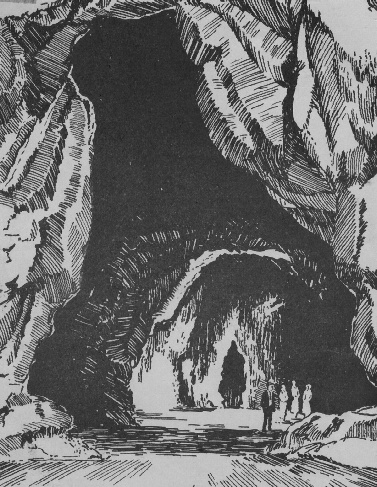
On Saturday the 6th July John, Richard, Peter and I went round 'Chislehurst Caves' - for 6d (£0.025). These being miles of mysterious unexplored druidical caves.
(It was quite a cold day when we cycled to Chislehurst. However, the caves were even colder, because they remain at 45 degrees Fahrenheit summer and winter. We must have got used to the cold because, when we came back out, we couldn't believe what a nice warm day it had become. There had been some sort of tourist narrow gauge railway through some of the caves in the past and I recall we found the remains of the open carriages in the entrance to a tunnel behind the entrance buildings.)
My original description, above, is somewhat minimalist so I've copied the following from the internet. Chislehurst Caves are a labyrinth of dark mysterious passageways which have been hewn by hand from the chalk, deep beneath Chislehurst. There are over 20 miles of caverns and passageways, dug over a period of 8000 years. The vast complex of caves are a maze of ancient mines originally carved out in the search for flint and chalk. They are divided into three main sections, Saxon, Druid and Roman. Each section was later connected by digging joining passages. The presence of chalk has been important to civilisations over thousands of years, and still is to date. Mining chalk provides Lime and Flint. Lime is the basic for plaster and whitewash paint, flint was used for manufacturing tools by early man and later for building. The mining activity is difficult to date however the mines appear on a charter circa 1250 and also in local church records of 1737. The last time the mines were known to have been worked was around the 1830's when the Saxon section was used by a flintmaker and limeburner. The local railway made the mines more accessable in 1865, and this aided its formation as a tourist attraction. The caves also became the setting for several underground concerts in the early 1900's. During the 1914 World War the mines became part of Woolwich Arsenal, used as an ammunitions depot. A narrow gauge railway was installed to aid the transport through the passages. Up until the outbreak of the Second World War the mines were used by the Kent Mushroom Company.
The Croydon Caving Club has a tour guide's commentary - "during the Second World War there were shops, canteens, cinemas, dance halls, a hospital a church and a gymnasium, for the caves were used as an air-raid shelter, sheltering over 15,000 people down here every night, and at that time electric lighting was installed in all the passageways. The caves were in fact almost an underground city on their own. So much so that when the end of the war finally came there was a great deal of difficulty in getting rid of some of the shelterers."
Please feel free to contact me by e-mail at elliottsimpson@hotmail.com
March 2006